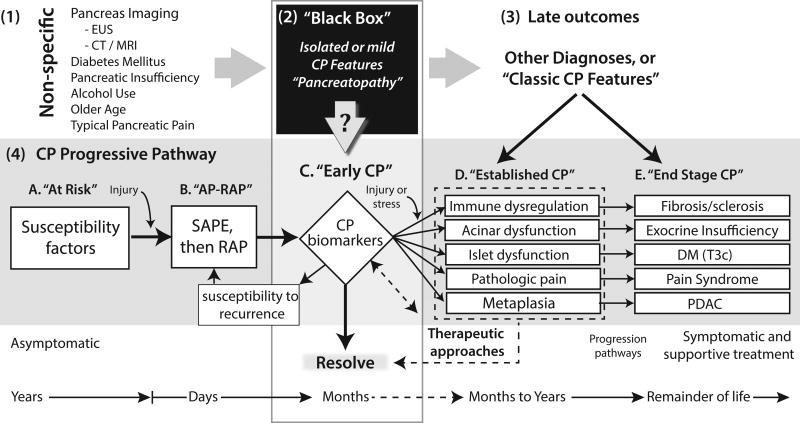Figure.
Relationship between the mechanistic CP progressive pathways (grey box, from4) and features of CP detected in various clinical settings. (1) Non-specific features of CP. CP often presents with non-specific signs and symptoms of disease that overlap with signs and symptoms of other diseases. (2) “Black Box” is a diagnostic placeholder and represents the situation where the mechanism of diseases is unknown, and no diagnosis can be made. (3) Late outcomes. With time, most serious diseases and complex syndromes will declare themselves. IN come cases CP has progressed to more severe, irreversible features of several biological systems that allow a diagnosis of classic CP to be diagnosed. (4) The CP Progressive Pathway represents the underlying complex mechanisms responsible for a person, over their lifetime, to develop chronic pancreatitis. In Stage A and B, the CP mechanism is seldom tested for or diagnosed. Stage C represents early CP, in which the high-risk mechanism IS known, inflammatory process is active (e.g. post AP), and some features of CP are also present. In this case the early features of CP within the Black Box, combined with the clinical setting and high probability risk profile is sufficient to make the diagnosis of Early CP. The challenge is to define the strength of various combinations of susceptibility and modifying risk factors associated with relevant systems within the pancreas, and early CP features (? In arrow pointing down from the Black Box) defining diagnostic criteria for Early CP. AP-RAP, acute pancreatitis and recurrent acute pancreatitis; CP, chronic pancreatitis; DM (T3c), diabetes mellitus Type IIIc or pancreatogenic diabetes mellitus; PDAC, pancreatic ductal adenocarcinoma; SAPE sentinel acute pancreatitis event18.

